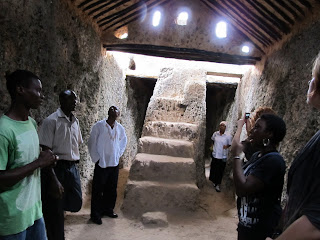Our first excursion was to Mangapwani. This is a giant cavern that was discovered in the early 19th century by a young slave boy whose goat fell into the opening. Inside the massive cavern, there are porous, jagged rocks all around. There is fresh water at the bottom, which many villagers use for drinking but this is a difficult task. The ground is composed of sharp rock and mud, so it gets very slippery. Carrying a giant bucket of water back up the cave can be extremely dangerous.
It is also said that the cave was used to hide slaves once the trade became illegal in Eastern Africa.
I had an eerie feeling as I made my way deeper into the darkness. We were able to see a small snake, a couple millipedes, and several bats.
These millipedes crawl into spirals that are bigger than my palm!
Every move we made was careful and slow. Our guides kept reminding us “Pole! Pole!” (pronounced poh-lay), which means to go very slowly. Water dripped from the ceiling as we navigated our way through the 1.6 million year old cave.
We were climbing over rocks, scaling the walls, and after about an hour, we reached a beam of light.
Along the way, we saw what looked like a memorial from Spanish travelers. They left their blessing here.
This was one of the guides climbing up behind me. He has been going through this cave for 10 years, but he still made jokes about not being able to find the exit.
We tried to get a group shot... It didn't work out too well, but you can see how dirty we got from crawling and climbing through the cave!
The last task was to lift ourselves up the narrow, vertical exit.
This spelunking adventure was by far the coolest thing I've done in quite some time.
Our last stop of the day was to Mangapwani slave quarters. Here we were able to learn about the history of the slave trade in Africa, and the steps taken to make this practice illegal.
We also got to see and walk through the underground rooms which held over 50 slaves on each side, separated by gender.
We walked a little farther to where the slave traders would pass the slaves off to ships in the Indian Ocean.
There we had lunch on the beach.











Wow that was an amazing excursion! and with a 104 fever?!
ReplyDeletenext time i find a cave like this, i'm bringing you down there with me, mom. what do you think?
ReplyDelete